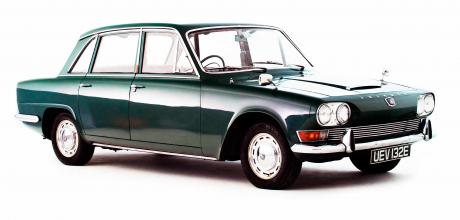Triumph 2000 1965-1976 Small six, big heart
Made by Standard-Triumph, just the Triumph name was used for automobiles and the company is better known for its sportscars such as the TR2, 3 and 4. The neat, simple name of 2000 was used until this was switched to Chicane in 1973 for the larger 2,5-litre engine. Leyland (which concentrated on buses and trucks) bought Standard-Triumph in 1960 and amalgamated with BMC/Jaguar to form British Leyland in 1968.
- Model: Triumph 2000 Mk II
- 0-62 (0 to 100 km/h): 16,00 seconds
- Top speed: 150 km/h
- Fuel index: 9,45 L/100 km (at 100 km/h)
- Price: $2850
- CAR test: July 1970 (plus 6 others)
PACKAGING
Both Mk I and Mk II models were styled by Michelotti and the cars were assembled at BMC/Leykor’s plant in Blackheath. The original design has a clean front with the air intake lower down and headlamps recessed into the bodywork. The revised styling saw a more conventional combined grille/air intake that incorporated the headlamps, while the rear lighting was changed from vertical to horizontal. The level of luxury was good, as befitted a more upmarket car than the Austin/ Morris staples. The cabin instrumentation panel of the Mk II was changed from recessed to a broader, concave panel and the car seated five adults comfortably. A 368-litre boot would have been larger still, had the upright spare wheel been better located.
POWERTRAIN
The stand-out feature of this Triumph is the straight-six engine. It produced 67 kW at 5 000 r/min and 118 N.m of torque at 2 900 r/min. A four-on-the- floor gearbox served the manual cars while a three-speed Borg-Warner automatic handled self-shifting duties. Stromberg carburation was used instead of the more usual SUs.
The generator was swapped for an alternator with the Mk II but power outputs remained unchanged throughout. As with so many cars of this era, there was a modified version by A&G Conversions. This used a highlift camshaft, increased compression ratio (to 9,5:1) and added a tuned exhaust manifold. This modification increased power significantly – by over 20% – and improved fuel economy. The Strombergs were retained as being up to the job. An overdrive option was offered with the Mk II with the switch neatly incorporated into the gearlever knob. This did not only lower the cruising-speed revs, but also decreased the measured fuel consumption by over 15%.
SUSPENSION AND STEERING
Independent suspension is employed all-round with semitrailing arms and coils springs at the rear instead of the simpler and cheaper leaf springs and solid axle. Braking is discs up front, drums at the rear with vacuum boosting for assistance. Steering was rack and pinion without power assistance so the number of lock-to-lock turns was set at a high 3,8; some ways off the two turns we see today on modern cars.
WHICH ONE TO GET
An overdrive model will be the most desirable and the early shape stands out much more than the conventional Mk II. Rust is the biggest issue with double and triple skins prone to rot. New parts may be difficult to come by but engines and gearboxes are quite strong.
AVAILABILITY AND PRICES
Sales bucked the usual trend of starting high and gradually tapering off over the years. The 2 000 sales kicked off at just over 1 000 per year, then rose steadily until reaching a peak of 2 450 units in 1969.With the release of the Mk II, 1 500 sales per year resumed till 1973 when figures declined until the introduction of the Chicane. Prices vary as usual with the condition.
INTERESTING FACTS
A specialist division of the Leykor Corporation was responsible for Triumph, Rover and Jaguar. The Triumph name (as well as Riley) was bought by BMW when it acquired the Mini marque but has not yet used them for new cars. Perhaps they’re keeping that one up their sleeve? The last Triumph made was the Acclaim; merely a rebadged Honda Ballade. In 1984, the Triumph badge was dropped in favour of Rover, still a rebadged Honda.
Upmarket British cars were expected to have wood trim inside, so Triumph followed Rover and Jaguar and included this. Rivals from the orient took note and so we see a Triumph rival like the Datsun 2000, also sporting a straight-six and following suit with its faux wood panelling (October 2019 issue). In high school, my English teacher drove a Triumph 2000 with the registration CA12. If only we could keep our numbers from back then. I had a motorcycle with CA183 which would also have been a keeper.
SPOTTED IN THE CLASSIFIEDS
Triumph 2000 AT 1965, red, good condition $9000
- 01 The frontal area of the Mk I is arguably the more attractive of the two.
- 02 Mk II instrumentation is typically British in its execution.
- 03 Small capacity straight-six is a standout feature.
- 04 The rear end of the Mk I also wear unique styling compared to the later version.
Parts & info: www.triumphexp.com, www.britishcarforum.com, www.clubtriumph.co.uk, www.triumphowners.com


